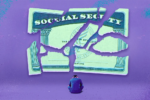Social Security scams are increasing across the United States, with fraudsters using deceptive tactics to steal personal information and money. These scammers often pretend to be government officials, using fear and urgency to trick individuals into providing sensitive details. Understanding their tricks can help you stay protected.
If you receive a suspicious letter, email, text, or phone call claiming to be from the Social Security Administration (SSA), do not respond. Scammers use these methods to gather information, demand payments, or threaten legal action. Knowing the red flags can prevent you from falling victim to these fraudulent activities.
What the Social Security Administration Will NEVER Do
The SSA has specific guidelines for communication and will never:
✅ Text or email images of an employee’s official identification – Scammers may send fake IDs to appear legitimate, but the SSA does not send such images.
✅ Suspend your Social Security number – Your Social Security number remains active for life, and no agency has the power to suspend it.
✅ Threaten arrest or legal action unless you pay immediately – Government agencies do not threaten people with immediate legal action. If you receive a call demanding urgent payment, it’s a scam.
✅ Demand payment via unusual methods – Be cautious if someone asks for payment through gift cards, wire transfers, cryptocurrency, or cash by mail. Legitimate government agencies will never request payments this way.
✅ Promise increased benefits in exchange for money – Any attempt to sell you additional Social Security benefits is fraudulent. Benefits are determined by law and cannot be increased through personal payments.
✅ Send “official” letters or emails with your personal details – Scammers may create fake documents that appear real, but the SSA does not randomly send letters or emails containing personal information unless requested.
When Does the Social Security Administration Contact You?
While the SSA does communicate with the public, they only do so in specific cases:
✔ Text Messages – You may receive a text message only if you have subscribed to SSA updates or as part of security verification for your my Social Security account.
✔ Phone Calls – SSA representatives may call you if:
- You recently applied for Social Security benefits.
- You are already receiving benefits and need to update your records.
- You requested a phone call for assistance.
If there is an issue with your Social Security number or account, SSA will send a letter explaining the problem instead of calling or texting.
If you owe money to SSA, they will mail you an official letter outlining payment options and your rights to appeal.
How to Recognize and Report a Social Security Scam
Scammers often use aggressive tactics to pressure victims into sharing information or making payments. Here’s how you can spot and handle these fraudulent attempts:
1. Look for Red Flags:
🚩 High-pressure tactics demanding immediate action.
🚩 Requests for sensitive information like your Social Security number.
🚩 Unusual payment methods, such as gift cards or cryptocurrency.
🚩 Caller ID showing “Social Security Administration” (Scammers can fake this).
🚩 Emails with urgent language and grammatical errors.
2. If You Receive a Suspicious Call, Text, or Email:
🔴 Do not respond, provide personal information, or make payments.
🔴 Hang up immediately if it’s a call.
🔴 Do not click links in suspicious emails or text messages.
🔴 Verify the legitimacy of the contact by calling SSA directly at 1-800-772-1213.
3. Report Scams to the Right Authorities:
🛑 Visit oig.ssa.gov/report to report suspected scams to the Office of the Inspector General.
🛑 Check www.ssa.gov/scam for updated scam alerts and safety tips.
🛑 Inform your friends, family, and colleagues about common scams to help protect them.
Why Spreading Awareness Matters
Social Security scams not only result in financial loss but also cause stress and anxiety for victims. Spreading awareness can prevent others from falling prey to fraud. The more people are informed about how scammers operate, the harder it becomes for these fraudsters to succeed.
If you receive a suspicious message or call, stay calm, verify before responding, and report it immediately. By staying informed and alert, you can help stop these scams and protect your personal information.
Disclaimer – Our team has carefully fact-checked this article to make sure it’s accurate and free from any misinformation. We’re dedicated to keeping our content honest and reliable for our readers.








